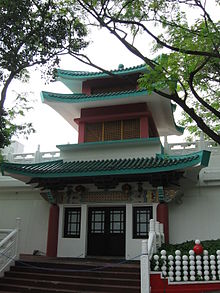Villa Haw Par
- Villa Haw Par
-
1°17′03.34″N 103°46′56.84″E / 1.2842611, 103.7824556
Située à Singapour, la villa Haw Par (chinois 虎豹別墅) représente bien le folklore architectural chinois. Elle fut construite en 1937 sous l’entrepreneur Aw Boon Haw à l'intention de son frère Boon Par. Elle est décrite comme, à la fois, fascinante, enchanteresse, bizarre et amusante, ne ressemblant à aucun autre lieu au monde. Son jardin est même surnommé le "Disneyland confucéen". Vingt-cinq groupes de statues et de figurines originales représentent des personnages de la mythologie chinoise comme le Bouddha ou encore les Fu Lu Shou (divinités taoïstes). Les frères Haw et Par s'étaient enrichis par la vente du Baume du tigre, une crème médicinale apaisante.
Elle est aujourd'hui transformée en parc à thème.
Liens externes
Sur les autres projets Wikimedia :
Wikimedia Foundation.
2010.
Contenu soumis à la licence CC-BY-SA. Source : Article Villa Haw Par de Wikipédia en français (auteurs)
Regardez d'autres dictionnaires:
Haw Par Villa — (zh c|c=虎豹别墅) is a Chinese mythological theme park in Singapore, located along Pasir Panjang Road.The park contains over 1,000 statues and 150 giant dioramas depicting scenes from Chinese folklore, legends, history, and illustrating various… … Wikipedia
Haw Par Villa — Das Eingangstor Die Haw Par Villa (Chinesisch: 虎豹别墅) ist ein Park der chinesischen Märchen und Mythen in Singapur. Er wurde 1937 für 1 Mio. Singapur Dollar erbaut und nach zwei Jahren Bauzeit fertiggestellt. Auftraggeber war … Deutsch Wikipedia
Aw Boon Haw — Dans ce nom chinois, le nom de famille, Hu ou Aw, précède le prénom. Aw Boon Haw (Who s Who in China 4th ed.,1931) Aw Boon Haw chinois 胡文虎 , pinyin : Hú Wénhǔ, (1882 Rangoon, Birmanie – 1954 Hong Kong) est un entrepren … Wikipédia en Français
Aw Boon Haw — (Who s Who in China 4th ed.,1931) Aw Boon Haw (Chinesisch 胡文虎, Pinyin Hú Wénhǔ; * 1882 in Rangun, Burma; † 1954 in Hong Kong) war ein burmesisch chinesischer Unternehmer. Haw entstammte einer Hakka Familie aus Yongding. Er war 1920 zusammen mit … Deutsch Wikipedia
Aw Boon Par — (zh cp|c=胡文豹|p=Hú Wénbào; 1888 – 1944) was a Burmese Chinese entrepreneur and philanthropist best known for introducing Tiger Balm, together with his brother Aw Boon Haw. His family was of Hakka descent and his ancestors were from Yongding County … Wikipedia
Aw Boon Haw — (zh cp|c=胡文虎|p=Hú Wénhǔ; 1882 Rangoon, Burma – 1954 Hong Kong) was a Burmese Chinese entrepreneur and philanthropist best known for introducing Tiger Balm. His family was of Hakka descent and his ancestors were from Yongding County in Fujian… … Wikipedia
Republik Singapur — Republic of Singapore (engl.) 新加坡共和国 (chin.) Republik Singapura (malai.) சிங்கப்பூர் குடியரசு (Tamil) Republik Singapur … Deutsch Wikipedia
Singapore — Republic of Singapore (engl.) 新加坡共和国 (chin.) Republik Singapura (malai.) சிங்கப்பூர் குடியரசு (Tamil) Republik Singapur … Deutsch Wikipedia
Tiger Balm Garden (Hong Kong) — For other places with the same name, see Tiger Balm Garden (disambiguation). 1965 photograph of some of the figures in the garden Tiger Balm Garden (虎豹別墅), also called Aw Boon Haw Garden, was located at 15, Tai Hang Road, Tai Hang, Wan Chai… … Wikipedia
Tiger Balm Gardens — Das Eingangstor Die Haw Par Villa (Chinesisch: 虎豹别墅) ist ein Park der chinesischen Märchen und Mythen in Singapur. Er wurde 1937 für 1 Mio. Singapur Dollar erbaut und nach zwei Jahren Bauzeit fertig gestellt. Auftraggeber war Aw Boon Haw, der die … Deutsch Wikipedia

